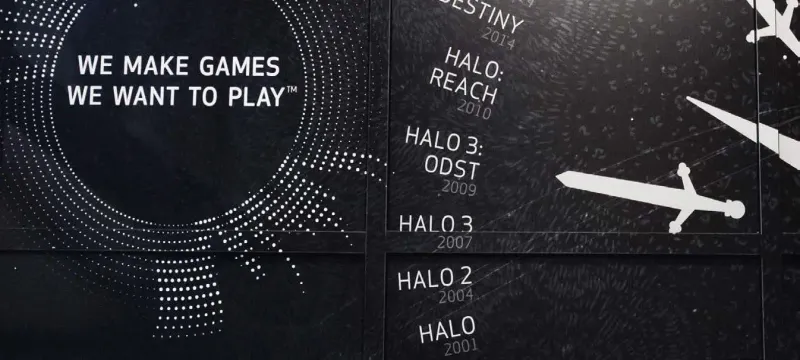Normalizing the hospital stay through entertainment
Recognized worldwide for creating the Destiny and Halo franchises, Bungie is a leader when it comes to entertainment. The company’s more than 700 employees spend their days living in video games, which makes their involvement in healthcare feel a bit unmatched. Since establishing in 1991, Bungie was always active in the community. In 2010 they formalized their philanthropic spirit with the creation of the Bungie Foundation. Its mission – to use their extensive knowledge in the entertainment space to ease the pain and discomfort children feel while in the hospital.
Identifying a need
Even with a general sense of what they wanted to do, the path to fulfill the foundation’s mission remained undiscovered. So, in 2012, The Bungie Foundation reached out to the local children’s hospital, Seattle Children’s, to identify gaps in their entertainment space. “We wanted to know how we could potentially solve some of their entertainment issues,” said Christine Edwards, senior foundation manager, The Bungie Foundation.
Creating a program to help
The foundation discovered that while the hospital received a lot of hardware donations, like consoles and games, they didn’t have staff to manage them. “So we went back to the drawing board to figure out how we could bring entertainment to kids in a way that wouldn’t be a burden to hospital staff,” Edwards said. “In that process, we created the iPads for Kids program.”
A unique offering within healthcare, iPads for Kids offers age-appropriate, customizable content to patients through an iPad at the bedside. “It’s intended to provide kiddos with a sense of entertainment, to give them the distraction they need while they’re in a really stressful or potentially traumatic situation,” Edwards explained. “We want to bring a sense of normalcy to their stay while they’re in the hospital.”
Thanks to a generous partnership with Child’s Play Charity, The Bungie Foundation is able to bring the iPads for Kids program to more children’s hospitals across the country.
Bungie and Child’s Play have the same goal. We both want to alleviate the suffering of kids in children’s hospitals. We want to bring in the power of play and entertainment to normalize a situation that’s not normal.
Drawing a roadmap
Though iPads for Kids is completely free for hospitals, even the zero-dollar price tag doesn’t erase the challenges of gaining hospital buy-in. “Intrinsically, we knew there would be challenges working within the hospital, but our passion to bring this program to life, and support patients and healthcare professionals, kept us going,” said Jim McQuillan, marketing creative director, Bungie.
For approximately one year, the foundation worked with hospital leadership, IT staff, quality control administrators and more at Seattle Children’s to explain their offering and ensure it met the hospital’s high security standards. In those early days, McQuillan explained, “The iPads for Kids program didn’t have a roadmap. Instead, there was a lot of trial and error, patience and listening to what would work best in a hospital setting.”
After numerous conversations and program adjustments, The Bungie Foundation kicked off the iPads for Kids program with an implementation of approximately 30 devices at Seattle Children’s. Pending availability, it allowed every child that wanted an iPad the opportunity to engage with technology as a means for distraction and a better hospital stay.
Heeding Apple’s advice
But as the program continued to expand, Edwards said they knew manually managing each device wouldn’t allow them to adequately meet the needs of the kids they served. A faster, more streamlined approach to their device management was essential to their success. They reached out to Apple for help.
“Apple told us that while there are a lot of mobile device management companies, and everyone will have something that might serve our purpose, Jamf is going to have exactly what we need out of the box, and it’s just going to work,” Edwards said. “They told us to give Jamf a call, so we did.” What happened next changed not only how the foundation managed the devices, but more importantly, it cleared the way for a stronger, brighter future for iPads for Kids.
“Jamf instantly became very, very passionate about our program and passionate about solving this problem. It became very apparent to us after having several conversations with other companies that there was just no comparison,” Edwards said. “Jamf was the way to go.” McQuillan agreed saying, “Connecting with Jamf was essential to completing our vision of the program. They brought the backend support we needed and the expertise to help us make a difference.”
Jamf instantly became very, very passionate about our program and passionate about solving this problem. It became very apparent to us after having several conversations with other companies that there was just no comparison,” Edwards said. “Jamf was the way to go.” McQuillan agreed saying, “Connecting with Jamf was essential to completing our vision of the program. They brought the backend support we needed and the expertise to help us make a difference.
Providing entertainment at the bedside
Together with Jamf, The Bungie Foundation provides a streamlined experience for patients as they enter the hospital. Once a new hospital is on board, Bungie provides an iPad for every appropriate hospital room. This allows patients to engage with pre-curated, ageappropriate content in a few simple clicks.
Upon entering their room and picking up the iPad, the patient selects their language, location and Wi-Fi. Then the patient (or family member) chooses their age range. This step automatically fills the iPad with apps that were pre-vetted and deemed appropriate and enjoyable for the patient’s age or ability level. And, if they don’t see their favorite app included, the patient can contact The Bungie Foundation to request additional content.
Upon the patient’s departure, the electronic medical record (EMR) system sends a specific discharge command to Jamf’s Healthcare Listener, telling it which iPad to wipe and reset back to factory settings. This workflow prevents protected health information (PHI), and any of the patient’s personal information, from ever leaving the device. “Jamf takes all that question, all that human error out of the picture,” Edwards explained about the need to meet a hospital’s strict security and compliance standards. “You click a couple buttons and say, ‘This is what I want on every single device every single time,’ and Jamf just does it automatically.”
iPads for Kids Workflow
- Patient is admitted
- Patient selects language, connects to Wi-Fi
- Device automatically configures
- Device goes into single app mode
- Patient/family selects appropriate developmental age
- Customized content (based on age) populates iPad
- Patient enjoys content during their stay
- Patient is discharged
- Jamf Healthcare Listener receives discharge command
- iPad is automatically wiped and ready for the next patient
Moving iPads for kids forward
“This year has proven to us and to hospitals across the country that the iPads for Kids program works for hospitals and works for their kids. This program is scalable. It has the potential to reach any patient at any age, regardless of what their certain circumstance is. And it can be a tool that helps them get through their stay,” Edwards said.
As a result of Jamf Pro’s automation tools, Edwards said the iPads for Kids program can scale to every children’s hospital in the country. “Jamf will for sure be along this ride with us from start to finish, because they have been so incredibly valuable to the success and the growth of our program,” she added. “We literally can’t operate the program as we need it to be without Jamf by our side.”
The iPads for Kids program began at Seattle Children’s, and it continues to gain traction. The Bungie Foundation estimates they’ll have the iPads for Kids program in six more hospitals throughout the U.S. by the end of 2018.


